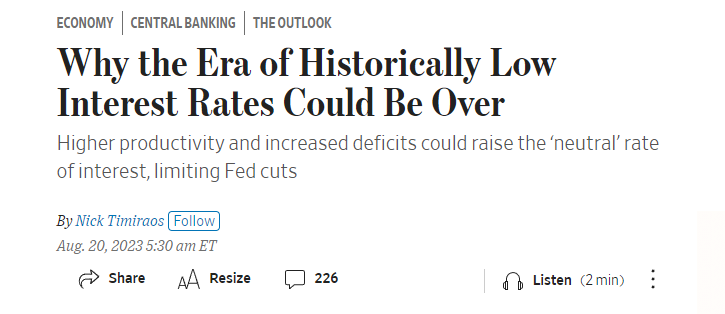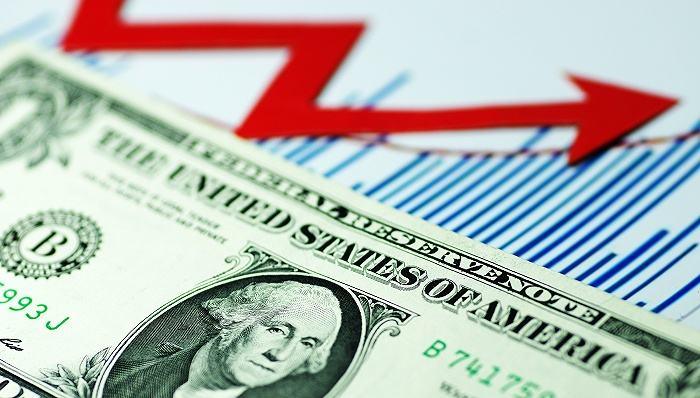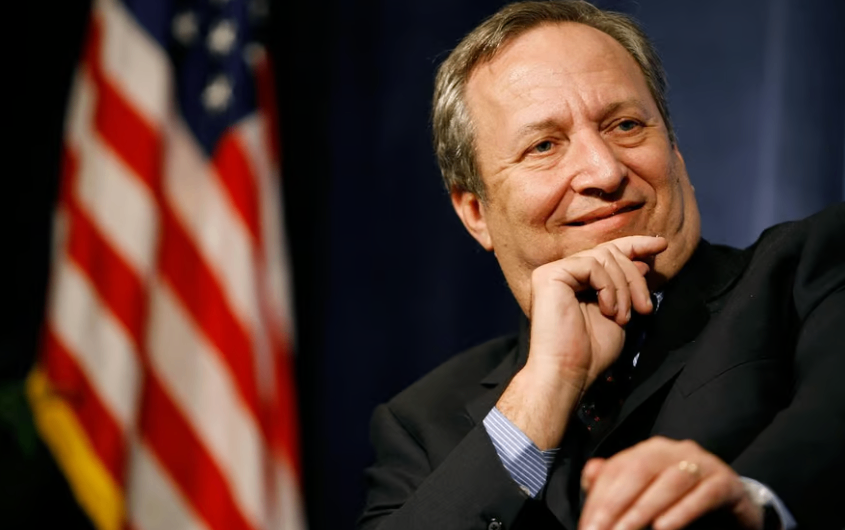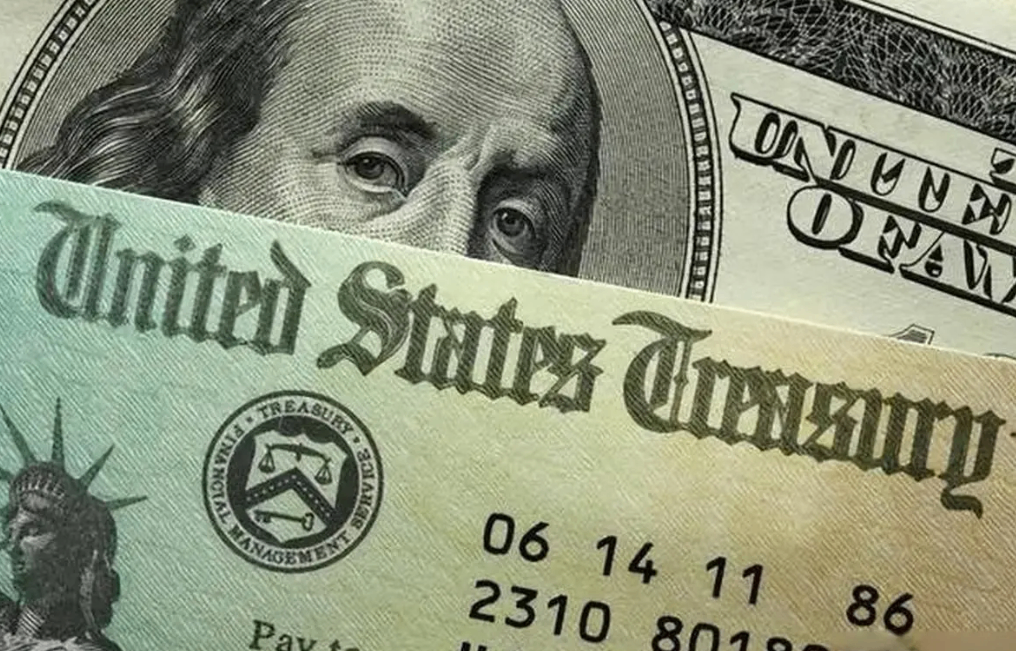U.S. debt may return to pre-financial crisis yields after the end of the U.S. interest rate hike cycle.
Last week, a strategist at Bank of America warned investors to be prepared for a 5% return in U.S. bond yields, a return to the pre-financial crisis U.S. bond market.。
Local time on August 20, known as the "Fed mouthpiece" of the Wall Street Journal reporter Timilos (Nick Timiraos) wrote an article on the platform, the Fed's interest rate policy at the end of the current interest rate hike cycle to make an outlook.。In his eyes, the era of ultra-low interest rates at the Fed is over。

"Fed mouthpiece": the era of ultra-low interest rates is over
Timilos noted that with inflation now down but economic activity still strong, estimates of the neutral rate are likely to become more important in the coming months。If the neutral rate rises, it may be necessary to raise short-term rates, or delay rate cuts as inflation falls。It could also keep long-term bond yields, which determine interest rates on mortgages and corporate debt, high for longer.。
The so-called neutral interest rate refers to an interest rate level that matches the real economic growth rate, which neither stimulates overheating nor constrains economic growth.。In other words, the neutral rate is the rate at which economic output is balanced with potential output (i.e., the level of output of the economy at full employment).。
When intermediate interest rates are close to real interest rates, economies are usually in a state of steady growth.。However, policymakers can regulate economic activity by influencing the behavior of real interest rates。In general, if the real interest rate is higher than the neutral rate, it will lead to higher borrowing costs and lower investment and consumption, which may have a dampening effect on current economic activity; conversely, if the policy rate is lower than the neutral rate, it may stimulate overinvestment and consumption, leading to inflation and instability。
Of course, an economy's neutral interest rate is not always set in stone, but is subject to a variety of factors and is thus in a state of flux。Specifically, the impact includes: economic growth, inflation, monetary policy, fiscal policy, labor market conditions, etc.。Publicly available data show that in 2019, the median interest rate expectation in the United States increased from 4 in 2012..25% down to 2.5%, after deducting 2% inflation, the real neutral rate is 0.5%。By June of this year, the indicator was still 0.5%。
The median hasn't changed, but some officials' forecasts are rising。In June, seven of the 17 FOMC members predicted that the real neutral rate would be above zero..5%, only 3 people below 0.5%。And a year ago, eight forecasts were below zero..5%, two higher than 0.5%。
However, in the eyes of Timilos, the neutral rate in the United States may already be at a relatively high level.。The name says the economy remains surprisingly resilient despite the Fed raising interest rates to their highest level in 22 years, and analysts expect growth to easily exceed 2 percent in the third quarter。This shows that currently 5.25% and 5.The 5% interest rate level is not too restrictive for the economy.。

For this view, Richmond Fed President Barkin (Tom Barkin) agreed, he said, conceptually, if the economy is operating at 5.above the 25% interest rate level, then to me that suggests that the neutral rate may be higher than we think。Separately, Joseph Davis, chief global economist at Vanguard, the world's largest public fund company, estimates that the real neutral rate has risen to 1 due to increased public debt..5%。
For the future interest rate environment, Timilos also gives a terrible idea。For now, with high economic growth and high government deficits, interest rates may not return to their pre-2020 ultra-low levels even if inflation returns to the Fed's 2 percent target in the coming years, he said in the article.。
The era of low interest rates, with neutral rates lifting U.S. debt, may also be coming to an end.
The movement of U.S. policy interest rates and U.S. bond rates are closely related, in the context of the recent plunge in U.S. bond prices and higher real yields on U.S. bonds, some big banks have warned investors that the era of low interest rates on U.S. bonds may also have come to an end.。
Last week, a strategist at Bank of America warned investors to be prepared for a 5% return in U.S. bond yields, a return to the pre-financial crisis U.S. bond market.。Meanwhile, BlackRock and Pacific Investment Management also said inflation will likely remain stubbornly above the Fed's target, leaving room for longer-term bond yields to push up further.。
As the Fed's rate hike cycle draws to a close, it's hard not to get the market's attention from the recent surge in U.S. bond yields。
As of late New York trading on the 18th local time, the U.S. 10-year benchmark Treasury yield was at 4.253%, 17 had touched 4.328%, close to the highest level since November 2007。30-year U.S. bond yields at 4.380%, 17 had touched the highest level since 2011 4.426%; the yield on the 10-year inflation-protected bond (TIPS), which best reflects the market's estimate of the inflation-adjusted real cost of funds, is reported at 1.942%, 17 hit the highest level since 2009 2.002%。
In fact, it's not just Wall Street's big banks and institutions that have noticed the movement in U.S. bond yields。On August 17, former U.S. Treasury Secretary Lawrence Summers also publicly stated that the rally in U.S. bond yields is likely to continue and far exceed the levels of the past two decades.。
Summers has considerable say in financial markets and monetary policy。
As early as his tenure as Treasury Secretary, he was active in promoting financial market reforms, including the adoption of the Gleason-Leach Agreement, which changed the financial industry by repealing Depression-era financial regulations and allowing for easier mergers and cross-operations between commercial banks, investment banks and insurance companies.。

In addition, Summers has maintained a close working relationship with former Federal Reserve Chairman Alan Greenspan (Alan Greenspan)。He supports keeping inflation stable and promoting economic growth, and achieves this goal by coordinating monetary and fiscal policy, and is one of the previous Treasury secretaries who has maintained more interaction with the Federal Reserve.。
Summers gives three reasons for higher U.S. debt in the future。First, long-term inflation is likely to be higher than in the past, possibly reaching 2.5%; second, given the government's growing borrowing needs, over time, the real interest rate may reach 1.5 to 2 per cent; third, given the term premium, which is compensation for investors buying long-term securities rather than rolling over short-term securities。Summers said that typically, the ratio averages about 0.75 to 1 percentage point。
Summers estimates that adding these three factors together, investors could "see 10-year U.S. Treasury yields remain at 4.75% and will even continue to move higher。
The importance of U.S. bond yields to global markets is self-evident.。The United States as one of the most developed countries in the world, U.S. Treasury bonds are also considered to be the core safety assets, that is, the so-called "risk-free assets," on this basis, the yield of U.S. debt can be regarded as a basic cost of funds, the rest of the cost of funds need to be priced on this basis, so the U.S. benchmark 10-year U.S. bond yield is called: the anchor of global assets.。

As such, higher U.S. bond yields could have a significant impact on financial markets。Specifically, the U.S. government's financing costs will increase, which could exacerbate the size of its already high deficit。In addition, when U.S. Treasury yields rise, fixed income investments will become more attractive, which could cause investors to shift from the stock market to the bond market, hitting share prices。In addition, the trend of U.S. bond yields will also have an impact on the real estate market, corporate bond market, financial market sentiment and other aspects.。
According to the schedule, the Jackson Hole Annual Meeting of Global Central Bank Governors will be held from August 24 to 26, Eastern Time, and the theme of this year's meeting is "Structural Transformation of the Global Economy."。On August 25, Federal Reserve Chairman Jerome Powell will speak。
The focus of the meeting will undoubtedly fall on "what action the Fed will take at its September policy meeting" and "whether the long-term inflation baseline will be higher."。
·Original
Disclaimer: The views in this article are from the original Creator and do not represent the views or position of Hawk Insight. The content of the article is for reference, communication and learning only, and does not constitute investment advice. If it involves copyright issues, please contact us for deletion.